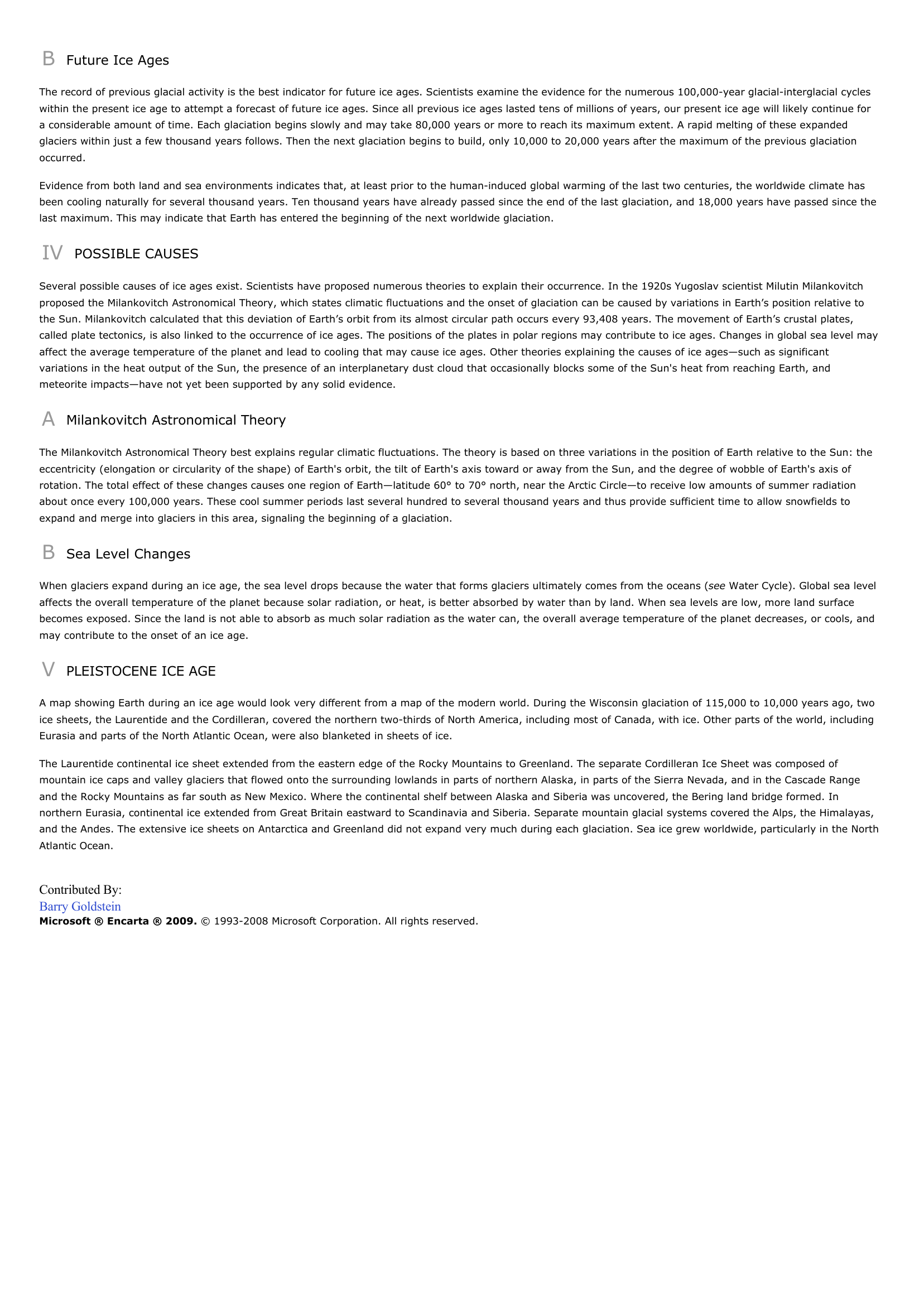Ice Ages.
Publié le 11/05/2013

Extrait du document
«
B Future Ice Ages
The record of previous glacial activity is the best indicator for future ice ages.
Scientists examine the evidence for the numerous 100,000-year glacial-interglacial cycleswithin the present ice age to attempt a forecast of future ice ages.
Since all previous ice ages lasted tens of millions of years, our present ice age will likely continue fora considerable amount of time.
Each glaciation begins slowly and may take 80,000 years or more to reach its maximum extent.
A rapid melting of these expandedglaciers within just a few thousand years follows.
Then the next glaciation begins to build, only 10,000 to 20,000 years after the maximum of the previous glaciationoccurred.
Evidence from both land and sea environments indicates that, at least prior to the human-induced global warming of the last two centuries, the worldwide climate hasbeen cooling naturally for several thousand years.
Ten thousand years have already passed since the end of the last glaciation, and 18,000 years have passed since thelast maximum.
This may indicate that Earth has entered the beginning of the next worldwide glaciation.
IV POSSIBLE CAUSES
Several possible causes of ice ages exist.
Scientists have proposed numerous theories to explain their occurrence.
In the 1920s Yugoslav scientist Milutin Milankovitchproposed the Milankovitch Astronomical Theory, which states climatic fluctuations and the onset of glaciation can be caused by variations in Earth’s position relative tothe Sun.
Milankovitch calculated that this deviation of Earth’s orbit from its almost circular path occurs every 93,408 years.
The movement of Earth’s crustal plates,called plate tectonics, is also linked to the occurrence of ice ages.
The positions of the plates in polar regions may contribute to ice ages.
Changes in global sea level mayaffect the average temperature of the planet and lead to cooling that may cause ice ages.
Other theories explaining the causes of ice ages—such as significantvariations in the heat output of the Sun, the presence of an interplanetary dust cloud that occasionally blocks some of the Sun's heat from reaching Earth, andmeteorite impacts—have not yet been supported by any solid evidence.
A Milankovitch Astronomical Theory
The Milankovitch Astronomical Theory best explains regular climatic fluctuations.
The theory is based on three variations in the position of Earth relative to the Sun: theeccentricity (elongation or circularity of the shape) of Earth's orbit, the tilt of Earth's axis toward or away from the Sun, and the degree of wobble of Earth's axis ofrotation.
The total effect of these changes causes one region of Earth—latitude 60° to 70° north, near the Arctic Circle—to receive low amounts of summer radiationabout once every 100,000 years.
These cool summer periods last several hundred to several thousand years and thus provide sufficient time to allow snowfields toexpand and merge into glaciers in this area, signaling the beginning of a glaciation.
B Sea Level Changes
When glaciers expand during an ice age, the sea level drops because the water that forms glaciers ultimately comes from the oceans ( see Water Cycle).
Global sea level affects the overall temperature of the planet because solar radiation, or heat, is better absorbed by water than by land.
When sea levels are low, more land surfacebecomes exposed.
Since the land is not able to absorb as much solar radiation as the water can, the overall average temperature of the planet decreases, or cools, andmay contribute to the onset of an ice age.
V PLEISTOCENE ICE AGE
A map showing Earth during an ice age would look very different from a map of the modern world.
During the Wisconsin glaciation of 115,000 to 10,000 years ago, twoice sheets, the Laurentide and the Cordilleran, covered the northern two-thirds of North America, including most of Canada, with ice.
Other parts of the world, includingEurasia and parts of the North Atlantic Ocean, were also blanketed in sheets of ice.
The Laurentide continental ice sheet extended from the eastern edge of the Rocky Mountains to Greenland.
The separate Cordilleran Ice Sheet was composed ofmountain ice caps and valley glaciers that flowed onto the surrounding lowlands in parts of northern Alaska, in parts of the Sierra Nevada, and in the Cascade Rangeand the Rocky Mountains as far south as New Mexico.
Where the continental shelf between Alaska and Siberia was uncovered, the Bering land bridge formed.
Innorthern Eurasia, continental ice extended from Great Britain eastward to Scandinavia and Siberia.
Separate mountain glacial systems covered the Alps, the Himalayas,and the Andes.
The extensive ice sheets on Antarctica and Greenland did not expand very much during each glaciation.
Sea ice grew worldwide, particularly in the NorthAtlantic Ocean.
Contributed By:Barry GoldsteinMicrosoft ® Encarta ® 2009. © 1993-2008 Microsoft Corporation.
All rights reserved..
»
↓↓↓ APERÇU DU DOCUMENT ↓↓↓
Liens utiles
- Friedrich W. J. Schelling, Les Ages du monde (résumé)
- DIX AGES DE CE MONDE (Les) de Gengenbach (résumé)
- QUATRE AGES DE L’HOMME (Des) de Novare
- KLIMT, Gustav : Les Trois Ages de la femme
- Pre?ov, ville de Slovaquie, au nord de Ko?ice.





